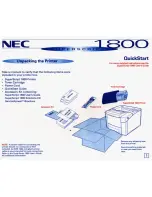
e-STUDIO166/206
© February 2007 TOSHIBA TEC CORPORATION All rights reserved
COPY PROCESS
3 - 2
3.2
Details of Copying Process
1) Photoconductive drum
The photoconductive drum consists of two layers.The outer layer is a photoconductive layer made of
an organic photoconductive carrier (OPC), and the inner layer is an aluminum conductive base in a
cylindrical form. The photoconductor has the following property: when it is exposed to light, the elec-
trical resistance it possesses increases or decreases according to the strength of the light.
Example:
-
Strong light
Resistance is decreased (works as a conductor.)
-
Weak light
Resistance is increased (works as an insulator.)
Fig. 3-2
[Formation of electrostatic latent image]
In the processes of charging, data reading, data writing, discharging described later, negative poten-
tial of the areas on the drum corresponding to black areas of the original are eliminated, while the
areas on the drum corresponding to white areas retains the negative charge.
As this image on the drum formed by the negative potential is not visible, it is called an “electrostatic
latent image.”
Fig. 3-3
Photoconductive layer
Base
Structure of the photoconductive drum
(Example of OPC)
0
Time (t)
Black area of original
White area of original
S
u
rf
a
c
e
p
o
te
n
ti
a
l
( V
)
Discharge
process
Charging
process
Electric potential of the photoconductive drum
-500
Summary of Contents for e-STUDIO 206
Page 6: ......
Page 10: ...e STUDIO166 206 February 2007 TOSHIBA TEC CORPORATION All rights reserved CONTENTS 4 ...
Page 68: ...e STUDIO166 206 February 2007 TOSHIBA TEC CORPORATION All rights reserved COPY PROCESS 3 14 ...
Page 88: ...e STUDIO166 206 February 2007 TOSHIBA TEC CORPORATION All rights reserved CONTROL PANEL 5 8 ...
Page 132: ...e STUDIO166 206 February 2007 TOSHIBA TEC CORPORATION All rights reserved DRIVE UNIT 9 10 ...
Page 236: ...e STUDIO166 206 February 2007 TOSHIBA TEC CORPORATION All rights reserved PC BOARDS 15 4 ...
Page 237: ......
Page 238: ......
















































